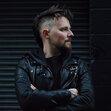Konn Lavery's Blog: Posts from konnlavery.com, page 35
December 31, 2018
Goodbye 2018
December 31st has arrived. New Year’s Eve. Goodbye 2018. What an exciting year it has been! First a huge thank you to everyone that has been a part of the journey throughout 2018. This post is the last Unprocessed Thoughts for the year and is going to be a summary and what you can expect in 2019 — goals and milestones. As cliché as they are, they do work, and we’ll talk a bit about them.
Welcome to Another Edition of Unprocessed Thoughts
Where did 2018 go? It feels like the whole year just buzzed by. There were conventions, panels, book signings, book launches, writing, studying and more! I’ll outline some of the big highlights below here.
2018 In a Nutshell
Okay, so to kick off 2018, the winter involved lots of planning for the launch of YEGman. This book was a huge learning curve as I was unfamiliar with the genre (or what genre it was) until post-launch. I know, shame. I didn’t quite do enough research. However, the book launched in the spring reached Edmonton’s best seller list, received a review group award and sold out at the Calgary Comic Expo. I also began an experimental monthly blog release of flash fiction. Not a bad start!
Slasher Experimentation
Following the launch of YEGman and the Calgary Comic Expo was the Calgary Horror con which, as with every year, is a blast. After the first wave of conventions, I began playing with a spring edition of NaNoWriMo. I wanted to see if I could apply some of the tactics I had learned in the Story Grid. I wrote a slasher novel during this time. Currently, the book is in the hands of beta readers and shelved. Why? Well, let me tell you.
Meeting the Rutherford Manor Crew
During the Calgary Horror con, I met the Rutherford Manor group. They have a lot going on. There is a haunt, a comic series, an album, an anthology and film. Our conversation evolved to having me on board to write the next book, their first full novel. I was beyond excited and took the opportunity.
Throughout the summer and fall, in-between presenting at When Words Collide and Edmonton Comic Expo, I researched and absorbed myself into the historical thriller world of Rutherford Manor. Oh, and Purity: Part III of Mental Damnation re-launched in the fall too. It was a busy year.
Descending
During the fall and winter, my graphic design and web development work pick up. I also had to write the Rutherford Manor novel. To achieve all of this I cut down future book signings, conventions and other events so I could plot, outline and draft the book in preparation for NaNoWriMo in November.
I did manage to sneak out to Austin, Texas for the A Perfect Circle tour with Tricky and Night Club.
End of the Year
With only two months left, I pushed into overdrive and hammered out the first draft of Rutherford Manor during NaNoWriMo in 11 days. From there, it was edits, lots of edits on top of juggling a massive wave of contract work and the holiday chaos. That brings us to where we are today, saying goodbye 2018.
Entering 2019 with a Goal
There were many more highlights during 2018 but to explore all of the fantastic things that happened this year; I’d need to write a book on it for you. The regular blog and the Unprocessed Thoughts do cover some topics in greater detail. So, moving into the new year, what is next?
Rutherford Manor Novel
All the hard work over the past six months have been a real ride, but the Rutherford Manor crew is active on their social media and sharing updates about the novel as we reach milestones. 2019, keep watch for the new book. More to come in the following months.
What else? What Goals?
Well, you can’t just release a book and say yay. As mentioned at the beginning of this post, the YEGman launch took critical planning for its success. So setting up goals and milestones for the whole year takes a bit of time. These goals include launching a book, where you want your author career to go and what type of person you want to be at the end of the year.
A beneficial resource is Chris Fox’s series on YouTube. He has a video called How to set SMART goals for 2019. He has a follow-up video that goes into more detail about it. The video is below. I’d recommend watching it if you have goals that you want to reach but are unsure where to go.
Have Fun, Stay Safe
To be honest, I haven’t fully mapped out the 2019 goals yet! It looks like I will be doing that in the new year. Today is a day to celebrate the end of another year. Goodbye 2018. For those that are leaving their home today to rejoice, have fun and stay safe. Catch you all in 2019.
Beer Note: The Grizzly Paw Brewing Company Grumpy Bear Honey Wheat
I’ve featured the Grizzly Paw beer a number of times on this blog. I like their beers. They come from Canmore and have a range of flavours. This one is their honey wheat beer that is all around tasty — not many hops and not too sweet like many honey ales. Now that more liquor stores are carrying the Grizzly Paw beers, I can get this one on a more regular basis. All that aside, with my hoppy taste buds in mind; I’d give this a 4.5/5.
The post Goodbye 2018 appeared first on Konn Lavery.
December 19, 2018
The Last of Ka’dubarh
On top of the frozen wasteland of Ka-dubarh, brave men defend their families and village from their enemies – the trolls. One man and one troll are the last, will there be peace? Or blood?
The Last of Ka’dubarh is December’s flash fiction that’ll bring readers into a fantasy themed battle. Experience the story in written word, audio, artwork and soundscape.
The Last of Ka’dubarh
Recall
Family means everything. This is something that has been engraved into the hearts of my people for centuries. Our blood is what binds us together. Unity is what makes us strong. The ancestry tree has been carried on for generations, keeping us robust and pure. Each new generation carries on the legacy of the last. We support one another, care for one another, and fight for one another. Even if it means the most significant sacrifice: our own life.
This is why I find myself on the frozen planes of Ka’dubarh, crawling over dozens of frozen corpses. Some of them I recognize, hell, I even had them over for wine and dinner back home. Now, their lifeless, cold faces are empty shells. Their souls have moved onto the afterlife. That leaves me here, alone, as the last.
My feet were numb. Possibly from the blood loss or the icy weather. I didn’t know, all I knew was I could no longer feel them, or walk on them. I had to crawl on my arms to push forward. The vast chasm leading out of Ka’dubarh was the one path that protects my people’s homeland from outsiders. If I could just keep pushing on, I could crawl down the mountain and back to the warmer wilderness. I could make it back to my family.
I let out a grunt, my arm gave out, and my face collided onto the ice-covered chest of a corpse. Pushing myself up, I looked over to see the head was a wrinkly grey colour with curled tusks and an elongated nose. Green-tinted icicles hung from the tip and the rims of the nostrils. That was no friend, it was one of my enemies.
“Damn trolls,” I muttered to myself. If they hadn’t been consumed by greed, maybe we would have been able to find some sort of common ground. We aren’t that different after all. It is only the names of our faiths that separate us.
A groan came directly under me as the chest began to move.
It Lives!
Oh no, I thought while pushing myself off of the troll. The being slowly lifted his limbs as his yellow eyes flung open. The ice cracked and crumbled as the body came to life.
“Goo’cha abu,” the troll muttered to itself while adjusting its helmet.
“Goddamnit,” I whispered while patting around my belt, where was my knife? I couldn’t find it, I had no weapon on me.
The troll rolled onto his side and looked up at me. His ice-coated face crunched into a scowl as he let out a nasty hiss, saying, “human!”
I extended my one hand, palm, outward, staring at the troll. “The battle is over, foe, we can go our separate ways, back home,” I said. Maybe I could reason with him. Perhaps we could come to some form of an agreement and leave this blood-filled snowscape.
The troll attempted to get up but collapsed with a yelp. His leg had an arrow through it, he was as crippled as I was.
“No battle over,” the troll said. “Your people shun us, and you will die for the dishonour.”
“This can be settled another day,” I said. “Go home, and I will do the same.”
“We fight, human.”
“We have fought! Look around you! Our comrades and friends lay slain. The battle is over.”
“No,” the troll reached around his belt until he pulled out a large jagged black dagger. “For my fallen brethren!”
I thought the cold was a difficult thing to deal with as is, now, I wish that was all I had. My hopes of survival drastically dwindled as I watched the troll crawl towards me, the knife in his mouth. With all my might, I pushed myself to the side to move away from him. The issue was, the troll was directly in my path leading back to my village. I needed to get around him.
“Humans will pay!” the troll shouted, drool running down his chin.
“Back!” I shouted, feeling the troll’s hand slap against my boot – a failed attempt to snag me. I picked up my pace, crawling faster, feeling my arms shake. The troll had longer limbs and would easily be able to catch up to me.
The Chase
The troll’s grunting and my panting accompanied by the crunching of snow was all that filled the soundscape as we crawled over our fallen comrades. I kept my eyes focused on the curved path I took around the troll. I could feel my lungs burn as my body begged for me to stop moving. It wanted me to end it all right now, stop trying to push forward.
I couldn’t give up. My wife and my son waited for me back home. I didn’t come to Ka’dubarh with my comrades to die here. I came here to defend my family and return to them.
A piercing sound filled the air as a sharp pain spiked from my ankle. I let out a cry of pain, realizing the troll had got me.
I glanced back while launching a kick at his face. Despite my numb foot, the boot was still an effective blunt object to my enemy’s nose. The blow made a crunching noise, causing the troll to hiss and back off. He let go of the knife in the process.
“Come on,” I muttered under my breath. Even with the knife in my ankle, I continued to crawl forward. The sound of the troll picked up, he was on the chase again.
“Your people hate our kind, kill our kind, I will gut you!” the troll called out.
At this moment, I realized I couldn’t out-crawl the troll, he had more energy. They were more resilient and had more stamina than humans. He wasn’t willing to be reasoned with either. I had to fight him.
“You,” I grunted while rolling onto my back, bending my stabbed leg towards my hand. “invaded our land.” I coiled my hand around the large knife. “Ka’dubarh is the sacred entrance!” I shouted while yanking the knife out of my ankle. Blood began to pour out of my wound and onto the snow, that wound had to be sealed soon. But first, I had to fend off my final foe on the battlefield.
The troll hissed and snagged both of my legs. “Ka’dubarh hides our holy temple.”
“Then why do you shed blood on the holy?” I growled while pushing myself upward, gripping the knife tightly.
I thrust the knife down, aiming for the troll’s arms. He let go of my limbs and rolled to the side. My knife stabbed into the ice, and I quickly pulled it out as I fell forward, crawling towards the troll in one smooth movement.
“Our ancient temple belongs to us!” the troll hissed while crawling on top of a troll corpse. He patted the body, searching for some sort of weapon. The troll’s face filled with a toothy grin as he pulled out a smaller dagger from the corpse’s belt.
“We will claim back our land,” the troll said as he scurried off the corpse and towards me.
End of All
Here we go, I thought as the sharp-biting wind picked up, blowing my hair in front of me. This was it, the final battle of Ka’dubarh.
The troll let out a roar as he forced himself onto his knees and slashed the knife at me. I rolled out of the way and plunged the blade into his outer thigh. The dagger pierced into his skin and he let out a roar. He backhanded my face, causing me to pull the dagger out of him as I landed on the snow. Thick forest-green blood oozed from his new wound.
“You will die, human!” the troll thrust the knife down at me, the blade pierced into my gut, and I let out a cry of pain. Gripping my dagger, I stabbed it up into his chest, piercing into his lungs.
The troll pulled his dagger out and thrust it down on me again as I did the same to him. Our weapons punctured our torsos repeatedly, causing green and red blood to spray over both of our bodies.
The troll let out a howl of pain as his body weakened, he nearly fell on top of me, using his one free hand to keep upright as he continued to stab me.
I cried in agony, clenching my teeth. The pain was only a thought in my mind, and I tried to ignore the powerful sensations that erupted from my wounds. I could feel the strength in my system begin to leave, I had no fight left, except for one last attack.
Letting out a roar, I thrust the blade further up from the previous stabs, this one piercing into the troll’s heart. He let out a gagging noise as he dropped his knife and his weight collapsed onto me. His tusks scraped against my cheek as his saliva drizzled down onto my face. The vile stench of mould and rotten meat reeked from his body, the typical troll smell. I just didn’t think it would be the last smell I ever smelt.
As I lay on the snow, in a pool of blood, my body began to warm up. The light from the sky started to become overpowering, causing all of Ka’dubarh to turn white. My overstimulated senses relaxed. My breathing was slowing down. The vile smell of the troll dwindled and was replaced with a soft sweet aroma. A familiar one. My wife?
My vision faded. Only the white light remained. I was warm now. I felt no pain. I could sense my family. I would reunite with them.
The post The Last of Ka’dubarh appeared first on Konn Lavery.
December 12, 2018
Marc Watson’s New Fantasy Novel, Catching Hell Part Two: Destination
In 2016 we had a special interview with Calgarian author Marc Watson who shared an excerpt from his unpublished fantasy novel. Since then, Marc has released two novel, Catching Hell (the fantasy novel), and Death Dresses Poorly.
Nowe we welcome him back to share the wonderful news of his sequel novel being released!
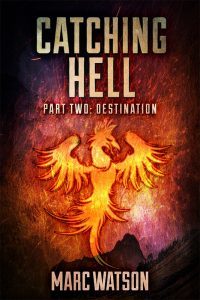 Technology and Magic Collide In the Second Installment of Young Adult Duology Catching Hell
Technology and Magic Collide In the Second Installment of Young Adult Duology Catching HellCALGARY, ALBERTA: As a self-proclaimed anti-author, Marc Watson’s success has a lot to do with his unconventional approach; he takes his writing seriously, but he’ll also be the first to tell you, sometimes, he’d rather be fishing on the river or watching his son’s play hockey, and manages to balance his time because he knows the stories he wants to tell are worth writing down. Marc also pushes the boundaries of genre fiction, and captivates readers with the question–who says you can’t have robots and magic in the same novel? Enter ‘Science Fantasy’ and Marc’s latest release, Catching Hell: Part 2 Destination released by Double Dragon Press.
On the heels of the release of Catching Hell: Part One Journey (April, 2018) which is still fresh in the minds of readers, Part Two Destination (November, 2018) continues the perilous journey of two best friends, Johan and Aryu, as science fiction and fantasy, technology and magic, collide in this epic finisher like no other. Avenging the destruction of their home was their goal, but with much more at stake, the robotic Army of Old, and the mysticism behind the Power, the two brave warriors will have to do more than just fight their fears if they are ever going to bridge the gap between them and reunite.
Marc, also a part-time writing student at the Athabasca University, is known for using a variety of writing styles to write effectively and believably his cross-genre fiction in order to engage readers with thought provoking world building and unforgettable characters.
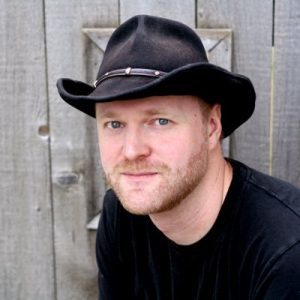 Catching Hell Part Two: Destination
Catching Hell Part Two: DestinationThe second part of this epic duology! A critical blow has been dealt to the robotic Army of the Old, but at a great price. Broken and weary, best friends Johan and Aryu have been separated while chasing forces from the distant past that they both fear.
Aryu, the man with wings, pursues the enemy while he slowly slips into the enticing magic and mystery of the Power, led by the great phoenix Nixon Ash.
Johan stands on the steps of Bankoor, a futuristic city full of wonder and mistrust. Here he must make his stand to avenge his destroyed home and find his friend.
As the gap between the brave warriors closes, the worlds of technology and magic will clash!
Learn More About Catching Hell on Double Dragon Publishing’s Website.
The post Marc Watson’s New Fantasy Novel, Catching Hell Part Two: Destination appeared first on Konn Lavery.
December 5, 2018
Author DIY Graphic Design – Layout
The layout is a critical part of all design projects. It is the final gatekeeper of how the public eye will perceive your work. In a way, the layout is the collage of all your previous efforts put on the page. We’ve previously discussed your design basics (shape, form, etc.), colour theory, and typeface. The previous topics all come together into the layout.
How to Start Your Layout

Making a layout will range drastically from a single column layout or multiple columns or even varying columns throughout the page. There are many options, as with all aspects of design and you can quickly become overwhelmed with the number of choices that you have in front of you. Remember, the critical thing in design is that design is functional art. We’ve discussed the importance of the scope of your project numerous times. The scope applies to your layout as well. This will help you break down what type of layouts you should use.
What type of project is it?
As authors, making our own designs, we might find ourselves designing a book cover, the interior formatting of our pages, a poster or even business cards. Each one of these will have a different layout.
Book Covers: Book covers tend to follow standard rules of large typography that will be easily readable if the book cover is shrunk to a small size (like on Amazon) or seen from a distance. Depending on your genre, you also have some freedom to explore creative ways of breaking up the text into rows or columns. Research your genre, examine what other book covers are doing, and see if that applies to your work.
Book Interiors: You don’t want to stray too far away from the standard one column layout with the interior of your book. Readers are familiar with this format, indentation and standard typography sizes (10pt or higher). You can explore some exciting typefaces and layout options for your chapter headlines, but it is strongly recommended not to push too far out of the ordinary and alienate readers. You could potentially lose sales.
Posters, Postcards, and Banners: Very similar to book covers, you want your posters and postcards to be eye-catching, easy to read and easy to understand. Your poster design might be for a book launch or book signing, or maybe it is a digital book release. Regardless, you will eventually need some form of advertising. Your layout will depend on the amount of information you need to display. If it is a banner, you will want the primary information to be seen upfront and centred while the secondary (contact information for example) can be much smaller when people are close to the banner.
Business Cards: Business cards offer a lot of Depending on the print shop you are working with, you have an array of paper types and finishing options. Regarding layout, usually, you have two categories: portrait and landscape layout. The amount of information you put on your card will affect the design as well. The less content on a business card, the more creative elements you can have on the card.
There are many other types of projects that you could find yourself doing as well. These are some of the more common projects, as an author, that you might have.
What is a good layout?
Now that we’ve discussed what type of project you have, and the common layouts used in these project types, we can use some design theory to make the right fitting layouts.
Grid Layouts
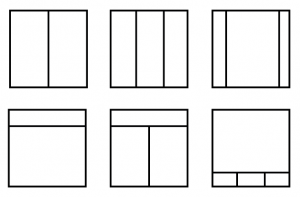
Grid layouts are a common way for designers to format their various elements (graphics, text and photos) onto the page. The lines and boxes shown in the example are merely for demonstration purposes. The boxes in a grid layout are to help guide you to know where to place your content and are removed upon your final design.
Grid layouts work exceptionally well when you are working with large sums of text, like a magazine, a website, or a book. The example in the top right with the two small columns and one full column is commonly seen in magazines, newspapers and social media sites. The reason? It is incredibly useful. The large column is your primary content and advertising goes in the smaller columns.
Golden Ratio Spiral
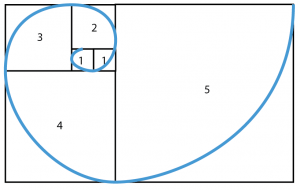
The golden ratio spiral is different from the grid layouts. It focuses on the hierarchy of information and drawing the viewer’s focus. As seen in the example, number one is the smallest square. Each square multiplies in size with five being the largest and the most visible. These squares would not be in your final design, but your elements would fit into these boxes.
Freedom to Experiment
You also have the freedom to play. The golden ratio spiral doesn’t have to be a wide rectangle as demonstrated. It could be rotated any way you wish. Once you start to train your eye, you can begin to bend and, dare I say it? Break the rules. Try a golden ratio spiral inside of a grid layout or vice versa.
Squint Eye Technique
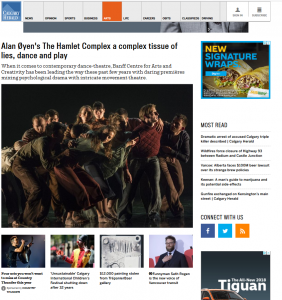
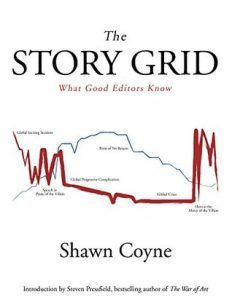
Still confused on what to do for your layout? Look at the two examples below, one is a screenshot from the Calgary Herald website and the second is The Story Grid book. Squint your eyes and see what elements are still the most visible. This technique is pretty old school and very useful. Squinting your eye shows you first hand what are the most apparent items on the page.
When you squint your eyes, are the essential pieces (like your book title on the cover) in your layout visible? Or is another element easier to see?
Your Exercise
Pick up a pen and paper and draw! I know, drawing is scary, we are more comfortable with words. Remember, you’re not making the next Mona Lisa, you’re making concepts to guide you on where to go next with your design.
Try drawing boxes on a small-scale size (like in the examples above) for your project or make up a project like a book cover. The smaller boxes inside will represent text and photos. Experiment with grid layouts and the golden ratio spiral. See what type of creative book cover layouts you can come up with!
The post Author DIY Graphic Design – Layout appeared first on Konn Lavery.
November 28, 2018
Double Up
October flew by, and I must apologize for not having completed an Unprocessed Thoughts for that month. Because of that, we will double up on inner thoughts, exciting news and even the beer!
Welcome to another edition of Unprocessed Thoughts
You might be wondering why I didn’t bother writing an Unprocessed Thoughts in October. Let us work backwards for this double up special bundle edition of Unprocessed Thoughts. October, that was a crazy month. After recovering from the Edmonton Comic Expo late September, I jumped right into finalizing the Rutherford Manor chapter outlines in preparation for NaNoWriMo in November. Oh, I also went to Austin.
The Austin Trip
Launching YEGman in the spring and Purity in the fall kept me pretty busy. I’ve also had a lot of exciting design and web projects on the go. Most are still in development, and I haven’t added them to the revealdesign.ca portfolio. When they’re done, I’ll be sure to share it. The point is, this year has been compact with lots of exciting – and stressful – things. I could surely use a mini getaway. I didn’t know where I wanted to go; there are many places in the world to visit. So, as I usually do, I looked around to see what bands are touring which cities and used that as inspiration.
A Perfect Circle, Tricky and Night Club
The choice was made. Seeing all three of these bands was a triple combo, not a double up! Tricky’s music has been a significant inspiration for me (I am a big trip hop nerd), and I’ve always enjoyed A Perfect Circle. Night Club is a project I’ve been following on and off since their formation. Each of them lived up to my internal hype.
The show was supposed to play the day I landed in Austin, but due to the rain and the outdoor venue, they rescheduled it to the following day. So, I had a free evening to figure out what to do. Luckily, Austin is known for their music scene.
Dance with the Dead, Daniel Deluxe and Zërowolf
I was pretty pleased with the rescheduling of A Perfect Circle; it allowed me to see one of my favourite synthwave bands, Dance with the Dead. The openers were enjoyable too. They played in a wide-open bar called Barracuda where I got to meet some of the musicians and answer everyone’s questions about Canada legalizing weed. Fun times.
The Rest of Austin
After knowing I was going to Austin, I looked up some of the best things to see. One of these included the Museum of the Weird which contained a guided tour of their specimens. I also got to hear the famous bats of Austin, explore the Whole Foods headquarters, Waterloo Records and Video, and visit the two-levelled Book People store. The Book People store was a dangerous place to venture. Thankfully I made it out of there with only one purchase.
Fast Forward – NaNoWriMo in 11 Days
After the A Perfect Circle show, I flew back to Edmonton the following day and did a book signing. That was the end of October. November 1st hit and I was beyond thrilled to start participating in NaNoWriMo. The last time I started was in 2015, and I have learned a lot about story structure, character development and methods to increase writing speed. All of this has been covered in my How to Finish NaNoWriMo in Two Weeks blog post.
The first week of NaNoWriMo was a half week, and it was a bit rough. I had a lot of other commitments with my contract work and personal life and wasn’t quite making the speed that I knew I could. By the time the second week started, my word count had jumped up drastically, and I managed to finish NaNoWriMo in 11 days. The first draft of the Rutherford Manor novel is now complete.
Reaching the End of 2018
There will be an Unprocessed Thoughts for December, I promise. Since NaNoWriMo was finished so early, I’ve been catching up on a lot of research with some reference material I have and backlogging blog posts. Why? Because I am preparing to go full force into the revision phases of the new novel and be ready for 2019’s ride.
Beer Note: Schneider Aventinus Weizen-Eisbock
Remember how I said we would double up? The Schneider Aventinus Weizen-Eisbock is a 500ml, 12% alcoholic beer. Remember when I said we’d double up even the beer? This beer has a kick, and it is not taking any prisoners. It is smooth, full of flavour and has no citrus to it at all. The German Eisbock is a slow-drinking beer that makes you want to savour every flavour as you ponder over all of the world’s issues, solving them one sip at a time. All that aside, with my hoppy taste buds in mind; I’d give this a 4/5.
The post Double Up appeared first on Konn Lavery.
November 21, 2018
Otherkin
In a small remote village, the town schedules their entire lives around sunlight. Anyone bold – or stupid – enough to be out at dark, are never seen again. Darold’s little brother Jack doesn’t understand why they should be afraid of the otherkin and tests the boundaries.
Otherkin is November’s flash fiction that’ll bring readers into a fantasy-horror themed creature feature. Experience the story in written word, audio, artwork and soundscape.
Otherkin
All Fun and Games
Normally I didn’t find myself wandering through the forest at dusk. The sun setting meant it was about to be dark, and that has everyone fearful. Being in a forest at night, hearing the soft singing of, “catch me, catch me. Don’t think you can. Guess I’m free! Hee! Hee! Hee!” echoed through the trees.
Hearing the silly song would be enough to send anyone screaming for their lives. No one else was out in the woods. Unfortunately, I know whose voice it was, and I couldn’t just leave him. What kind of brother would I be?
“Quit playing around!” I called out. “Mom is going to be mad at us. It’s past dusk.” I stepped through the slippery ground, carefully avoiding the creek, so I didn’t fall into the cold water. My rubber boots were covered in mud, overalls dusty. This was a trio of all the things that put grey hair on our mother’s head.
“Jack!” I called out again. This is downright childish, I thought. Jack knew the dangers of being out in the dark. He was a child, but that didn’t make this any easier.
A splash came from the creek, catching my attention. It was too dark to see what hit the water, but the ripples came in my direction. “Jack?” I asked, taking a step closer to the sound. The closer I got, I spotted a half-wet rock. In the dark, the narrow shape made it look like a strange mask.
“Cut it out!” I called out.
Ruffling came from the nearby shrubs. That had to be Jack.
I stepped away from the creek and hurried over to the sound. The ruffling continued, and I could make out branches of a bush shaking around.
Got’ya, I thought as I slowed my pace, creeping up to the bush. The plant continued to move at a consistent pace as I came arm’s length from it.
“Jack!” I shouted while jumping over to see the other side of the bush. Nothing. The bush continued to shake. Was Jack inside?
“CAW!!” came a high-pitched scream as small hands snagged my forearm.
I spun around while letting out a yelp. Beside me was a small blonde kid in a tattered blue coat – my brother.
“Jack!” I slapped his head. The bush stopped moving. “What the hell is wrong with you?” I asked.
“Ow,” Jack said while raising his one hand with string. “I got you good.” He pulled on the string, causing the bush to move.
“Very funny. We’re so late. We have to get home. Come on.” I snagged my little brother’s hand and marched down to the creek.
“We’re just playing,” Jack said. “Look how far we got today!”
“Yeah,” I said. “We can explore more tomorrow, just before dusk. This was way too risky.”
I understood my brother’s enthusiasm for going further up the creek. Our goal was always to see how far into the forest we could make it before dusk arrived. Considering we were on a strict time limit, it created a gamification aspect of exploring the woods. He just took it too far today.
“Mom is going to freak out,” I added.
“No, she won’t,” Jack said.
“Yes, for all we know they’re prepping a search party for us.”
“They’ve never done that. The otherkin would get them.” Jack said.
My brother had a point, no one ever seemed to do much when someone went missing in the forest. Once darkness hit, it was too risky to try and send in a search party. The lost quickly turned into the deceased in the eyes of the village.
“Alright,” I said. “You got me there. Just please don’t pull that kind of stuff again. Otherwise, the otherkin will get you too.”
Back Home
The two of us followed the creek back down to the village, leaving the thick forest, and onto the grassy foothills. There were a couple of lights coming from the homes down below. The rest of the village was blacked out. Lights off by dusk was the wisest thing anyone could do.
We reached the gravel road and walked into town, leading to our home. I couldn’t help but think how mad mom was going to be about all of this. She would have my head because I was the older brother. ‘Little Jackie’ couldn’t possibly do anything wrong.
Jack scratched his head, saying, “I’ve seen one.”
“What?” I asked.
“An otherkin.”
“That’s a big pile of crap,” I said.
“It’s true!” Jack argued.
“No way. You’d be dead.”
“Nu-uh.”
“No one has survived seeing one. People simply go missing.”
“Then how do you know they’re real?” Jack asked.
“Because we can hear them. We’ve found their nests and feathers. Oh, then there’s the obvious fact that people go missing,” I said.
“Not all of them, they’re not much different than us. They’re like, ‘kin’ more so than ‘other.’”
I shook my head, there was no point in arguing with my little brother. He had a mind of his own, hence the fiasco tonight. He was convinced he saw an otherkin. The boy had an active imagination, and there wasn’t much else to be said about it.
“You’d have to be out super late,” I said. “You couldn’t have seen one.”
“No, sometimes they are awake during the day.”
“Not from what I’ve heard.”
Jack and I strolled on home. Our house was one of the houses with their lights on. By the time we reached the front door, it had opened, and both my mother and father stepped out.
“Darold, Jackie!” My mom said, rushing up to us. She got down on her knee and took Jack by the shoulders and examined him thoroughly. “What on earth were you two doing?”
My dad put his hands on his hips, saying, “do you have any idea how late it is? You could have been killed!”
“Yes,” I said. “I am aware. Jack wandered a little too far again.”
“Heavens no!” mom said. “This was well past sunset. Jack, you got lost.” She wrapped her one arm around Jack and the other around me, bringing us both in for a tight squeeze.
I looked up at my dad who stared down at me, saying nothing. With a glare like that, I knew he was blaming me for this stunt.
A distant chatter roared through the skyline. It was high-pitched, almost like the sound of a little girl laughing.
Dad exhaled and waved his hand, saying, “let’s get inside.”
“That’s earlier than normal,” mom said while standing up.
“We haven’t seen much other wildlife over the past few weeks,” Dad said. “They’re hungry.”
Routine
The four of us hurried into the home. Dad locked the door and reinforced it with an additional plank of wood. Mom extinguished all the candles, leaving us to wander through the darkness. This was usual, we made sure everything was off the floor, and we could easily get to our shared bedroom. It was much safer sleeping in a group rather than separate rooms.
Dad kept his rifle with him, mom at his side and my brother and I between them.
Shouts and cries began to pick up outside. They were muffled, but they were the usual sounds we heard most nights when the otherkin came out.
“Don’t do that again,” mom whispered.
“Okay,” I said.
A thud came from above, causing us to look up. Dust fell from the ceiling as heavy thumping picked up.
Chattering and laughter came from outside. The sounds brought back the memory of when I first heard the haunting sounds of the otherkin, now, it was just another day of life. Another day of survival.
The thumping stopped as several big gushes picked up until the sound faded.
My dad exhaled heavily. “I hate when they peck the roof.”
The rest of the night was uneventful, and the four of us managed to get some sleep. We usually get up at about sunrise, when the otherkin returned to their nests. We attended to the village’s farm with our daily tasks, ate, and continued our work throughout the afternoon.
After dinner, my brother couldn’t wait to get out of the village and get back to the creek to see if we could make a further hike up to the forest. Maybe this time we would find an animal corpse – leftovers from the otherkins’ meal.
“Darold,” mom said. “Please don’t stay out that late again. Come back before dusk.”
“We will,” I said.
“Promise?”
“Promise.”
After that, mom gave us the approval and we hurried out of the house and followed the road leading into the forest.
New Records
Jack and I walked up the creek as per usual after dinner. This time I would keep a closer eye on the kid, make sure he didn’t get any wise-ass ideas to pull a prank on me. The last thing I wanted was to get another lecture from my dad about responsibility. Jack was lucky, he was the baby in the family and didn’t have to hear about responsibility.
The two of us wandered the creek up to where the long, mask-like rock rested in the stream. In the daylight, the shadows didn’t quite cast the same visuals. Either way, this was the last point we were at the previous night. We made good time.
“I need to pee,” Jack said, stopping in his tracks.
“Just go behind that tree,” I pointed to the large tree behind us.
Jack hurried away from the creek, carefully stepping around the slippery mud and up to the tree. He moved around the trunk and out of sight. A whizzing sound came from behind the tree. Then there was silence.
“Jack?” I called out. “Come on out, no games this time.”
“Catch me, catch me. Don’t think you can. Guess I’m free! Hee! Hee! Hee!” came a soft voice.
“Cut it out!” I hurried up to the tree trunk as my brother peeked around.
“Hi!” Jack said.
“Don’t sing that song. I’m so tired of your jokes.”
“I didn’t.”
“Excuse me?” I asked, eyeing my brother closely.
“I didn’t sing that,” Jack repeated
“You mean right now? Don’t mess with me.”
“C-a-ch me, c-caw-ch m-m-aw…” a voice picked up in the forest.
A metaphoric spider crawled down my back, standing every hair up on my skin. “Jack,” I said. “That song was never you, was it?”
A branch snapping came from the tree directly above us, causing debris to fall. I brushed leaves and wood splinters from my face until my hand came into contact with something soft. It was like a leaf, but grey. I snagged it off my face to see it was a feather.
The Otherkin
With no words, I snagged my brother’s hand and skidded down from the higher ground. Scraping came from above as bark tumbled down onto the dirt behind us. We reached the creek and sprinted down the forest, carefully avoiding the mud and slippery rocks. A thud came from behind as a large squawk roared through the woods.
Thumping echoed our footsteps, they were heavier and picked up in speed.
Don’t get us, don’t get us, I thought, tightening the grip on my brother’s hand. My knees began to ache from my legs slamming onto the descending ground.
“C-C-AW-TCH M-AH!” came a high-pitched scream behind us. “C-C-AW-TCH M-AH!” It sounded close, the stomping was unsettlingly louder.
Please don’t, please don’t, I thought. Was it right behind us? I honestly didn’t know. The trees in front of us were further apart, we were in the outskirts of the forest but still too far from the grassy hills and the village.
The stomping increased again, and I could hear the sound of ruffling feathers.
I couldn’t help it, I had to see what was behind us. If this was it, I had to see my nemesis. I turned my head to look back, just one quick glance.
My foot slipped on a rock, and a tumbled forward, still holding onto my little brother, falling directly into the creek, my face had to hit a rock because I slid into something hard. This was it, we were the otherkin’s next meal.
A deafening rifle roar echoed as the being behind us squawked. Several gushes of wind picked up as I rolled onto my back, wiping my face clear of the mud and blood.
In the sky, I could see a silhouette of a humanoid with wings and sharp talons for feet. The creature was too close to the sun, and I couldn’t make out any more details as it flew above the trees, further into the forest, and disappearing from sight.
My little brother cried, he was beside me, on his knees, covered in mud and water.
Further down the creek, I saw a tall man with a rifle as smoke escaped the chamber. Dad. Victor of the otherkin.
The post Otherkin appeared first on Konn Lavery.
November 16, 2018
Richard Paolinelli, sci-fi and fantasy author of Escaping Infinity
This month’s guest is Richard Paolinelli who comes from a sports writing career. In 2010 he retired from this craft to return to his fiction roots and follow his passion of storytelling. He had released two short stories The Invited and Legacy of Death – as well as a full-length sci-fi novel, Maelstrom prior to 2015. Since then he continues to write new works of fiction.
Let’s welcome him to the blog and learn more about what he is writing!
Thank you, Richard Paolinelli, for joining us, can you give a brief introduction of yourself?
I began my writing career as a freelance writer in 1984 and served as the lead writer for the first two issues of the Elite Comics sci-fi/fantasy series, Seadragon. In 1991 I was hired as a sports writer for the Gallup Independent in New Mexico and worked for papers in New Mexico and California and won the 2001 California Newspaper Publishers Association award for Best Sports Story.
In 2010, I retired as a sportswriter and returned to writing fiction. I’ve written six novels – including the Dragon Award Finalist (Best Sci-Fi Novel), Escaping Infinity – three Sherlock Holmes pastiches, two non-fiction sports books and three novellas. I’m serving as co-editor for one of the 11 volumes of Superversive Press’ Planetary Anthologies (Pluto) and will have short stories in several of the other volumes as well as three other anthologies that are to be released throughout 2018. My third full-length science-fiction novel, When The Gods Fell, is scheduled to be released on September 4, 2018 by Tuscany Bay Books.
I’m a partner in Tuscany Bay Books with Jim Christina, a co-host on the weekly radio show, The Writer’s Block on LA Talk Radio, and I recently founded the Science Fiction & Fantasy Creators Guild (www.sffcguild.com) a not-for-profit organization aimed at promoting science-fiction and fantasy and its creators in many media platforms.
Tell us about your latest novel, Escaping Infinity, which was nominated for the 2017 Dragon Award for Best Sci-Fi Novel.
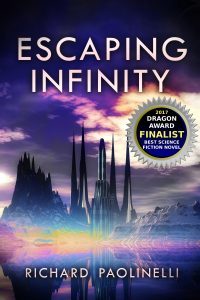
I’ve often said I could write a book about the journey writing this particular book took. It’s a sci-fi/thriller that deals with a traveler who checks into an amazing hotel out in the middle of nowhere and quickly discovers that there is no way back to the outside world. Not only that, it appears tomorrow never arrives inside the Infinity Hotel, and with the aid of an enigmatic front desk clerk he fights to escape the trap he has found himself in. But he eventually discovers there is a lot more riding on him solving the mystery than just getting back out.
It has been very well received and was honored with being a Finalist for Best Sci-Fi Novel in the 2017 Dragon Awards at DragonCon. It was also nominated by a few members of the SFWA for a Nebula Award. While it did not earn enough nominations to be a final nominee for a Nebula, I was incredibly honored that fellow sci-fi writers thought that highly about the book to put it up for consideration. It has also picked up three other awards, including one for its cover, and I have been very happy with the recognition the book has earned.
Shifting careers into writing fiction is a big jump, tell us about how you approached this transition? Was it night and day or was it a slow migration?
I think the fact that early in my freelance writing days (1984-1991) I was writing a little bit of everything. Stories on a meteor crater in West Texas one day, a golf tournament the next day and the story/script for a small comic book series the next.
So after my years as a newspaper writer (1991-2010) ended and I decided to go back into fiction writing it really wasn’t that huge of a culture shock for me. What made it easier was that while I was working on my fiction novels, I was also tackling a couple of non-fiction sports books that I released in 2015 & 2016. So I never really felt like I was a fish out of water or anything like that. Now that I am about 18 months into doing nothing but fiction it feels very comfortable. I imagine if I wanted to, I could take on another non-fiction sports project and still manage to crank out fiction works without having to adjust too much.
What do you personally prefer writing – Science Fiction or Fantasy?
I’m definitely more of a sci-fi guy, but I still manage to incorporate some elements of fantasy in my sci-fi novels where I can. Oddly enough, the book I am working on right now is more fantasy with sci-fi elements in it.
These genres often require a lot of backstory and world building, do you have a system in place for it?
Not really a system, per se. I tend to focus on my characters’ backstories more in my stories. But I don’t mean to downplay world building in the slightest because it is as important.
When I start to create my next novel, in addition to a synopsis and outline with notes, I do build a bible of sorts with all of the additional information that I feel needs to be worked into the story at some point. I have found that this helps me build up the world the novel exists in as well as develop the people and creatures that inhabit it.
What’s next in your writing career now that Escaping Infinity is released?
This year will see stories I’ve written appear in several anthologies – I’m even editing one of the Planetary Anthology Series (Pluto) by Superversive Press – and I am just about done with my next sci-fi novel, When The Gods Fell, which is due out in September. I am hoping to close out the year with one more sci-fi novel, Cursed Firstborn, as well.
But a project I am really looking forward to completing this summer is a pre-teen sci-fi/fantasy novel that I am writing with my eldest grandson. The working title is, Timeless, and I hope it will be the first in a series of books.
For aspiring writers, what would be one piece of advice you would give them?
Keep writing. If this is your passion then don’t let anyone talk you out of doing it. You will learn something new about the craft every time you write the next story that will make you a better writer. So keep writing, keep learning and in case I haven’t mentioned this yet, keep writing!
Let’s thank Richard Paolinelli for joining us to talk about him writing!
You can find Richard Paolinelli’s work at the links below:
You can also follow online him at:
The post Richard Paolinelli, sci-fi and fantasy author of Escaping Infinity appeared first on Konn Lavery.
November 15, 2018
Interview on the Just Joshing Podcast
During When Words Collide I was a guest on the Just Joshing podcast where we discuss my writing, YEGman and the meaning of life. We had a lot of fun while in the hotel pub. Give it a listen below!
The post Interview on the Just Joshing Podcast appeared first on Konn Lavery.
Guest on SHOUT for Libraries Podcast
October 2018 I was a guest on the SHOUT for Libraries podacst where we discuss my horror novel Seed Me. Give the podcast a listen below!
The post Guest on SHOUT for Libraries Podcast appeared first on Konn Lavery.
How to Finish NaNoWriMo in Two Weeks
November is upon us! Another year of NaNoWriMo. For those that do not know, NaNoWriMo is the National November Writing Month. You can find out more on their website. 2018 was the first year I’ve participated since 2015. You can learn a lot in three years away from something. Needless to say, I was pretty excited to tackle the 50,000 words in a one-month challenge with all of my new experiences.
November 1st hit and NaNoWriMo began. The first couple of days I was slow at getting into the rhythm, but I found a consistent groove. Eleven days later I reached 50,450 words, an average of 4,500 per day. A number of people were curious about how I achieved this, so this blog post will shed some light on how you can do NaNoWriMo in two weeks too.
NaNoWriMo in Two weeks? How?
Let’s back up a few months, because the truth is, the writing process began before November. This does not include the first draft. You can save a ton of time during NaNoWriMo by doing some… planning!
Planning for NaNoWriMo
That headline will make pantsers shiver. Planning? That’s crazy! Plotters aren’t more effective than pantsers. Personally, I do a bit of both. There’s a lot to be said for improvisation. Before NaNoWriMo starts, you probably have some idea what you want to write about, otherwise, why else are you participating?
You’ll want to start thinking about NaNoWriMo probably a couple of months in advance, if not even further back, like in July. NaNoWriMo sends out newsletters throughout the year and reminds you about the looming November first. They encourage planning too!
While planning for NaNoWriMo, you’ll want a document (or pieces of paper) for each of the following:
Premise and Goals: This document includes, your premise, word count goal and genre. This process is taken right out of the Story Grid book by Shawn Coyne (mentioned further down). Writing down your premise is the starting point of knowing what story you’re writing. Some of this is covered in an earlier blog post series titled ‘Want to Write a Fiction Novel?’ too.
Character Sheets: This is the most valuable document. Character sheets are your first introduction into the people that make your novel real. Define their wants, desires, goals and struggles. The sooner you become familiar with your characters, the more intuitive their actions, and dialogue will be in your writing. Characters are covered in a blog series I wrote if you want more information on the topic.
Outline: Now that you have a premise and your character sheets, it is time to scope out the plot. Your outline can be as unclear or as detailed as you like. I limit my chapter outlines to vague, one-pagers. Some people plot down to the beat of the novel. Find a comfort zone for you. You’re looking to give yourself a general path of where the story will go from chapter to chapter. The outline is not written in stone and chances are you’ll make changes to the story in the first draft.
Research: I saved this as the last point, not that these bullets are in numerical order, but research is incredibly important. Depending on your genre, this could mean world building or studying an industry or learning about a specific time period. The more you research about your world/time setting, the less guesswork you have to do in your first draft. Research can also spark ideas for scenes. A more detailed blog post on research can be found here.
More Pre-planning Means Less Work in November
The planning points mentioned are all about exploring the creative work from a story and plot perspective. So when November first hits, you can focus entirely on the flow of the first draft. You’re not distracted by trying to come up with scenes, where the story is going, or getting to know your characters. You’ve done all that and have a clear roadmap on where to go and are familiar with how your characters are going to behave. You won’t be juggling a bunch of tasks in your head. You can focus on one job: writing an engaging first draft.
Don’t Edit!
Not editing is a no-brainer that is stated by many people during NaNoWriMo. I thought I’d touch base on it though to reiterate the importance of not editing. While writing your first draft, put that editor hat aside and be the writer! Sure, your draft is going to have typos, you’ll probably delete that sentence you just wrote, and that is okay. Your goal in the first draft is to create something to work with for the second and third draft when you do put the editor hat on. Make mistakes and get messy.
Writing Ritual
Life is crazy, and we all have obligations that keep us away from writing. In a perfect world, we could write all day and take our time. Because we are limited to 24 hours per day, we can only do so much before we go insane.
To fit NaNoWriMo into your day, dedicate a time to focus on your writing. Write at this time every day. This will become your writing ritual for the month. The dedicated time could involve getting up an hour early each day or going to be an hour later. The routine might be split into fragments, possibly a bit during your lunch break or just before dinner. Either way, set some time aside every day and put that phone away. If you need more info on distractions, check out a blog post I wrote on it.
Slow and Steady Wins the Race
Let’s reference that old fable involving the tortoise and the hair. NaNoWriMo is more like a marathon than it is a sprint. Keep yourself at a steady pace and track your word count, NaNoWriMo has a ton of fun stats to help you plan your progression. Write each day consistently and don’t over-do it one day just because you can. You’ll risk burning yourself out for days to come and set yourself back.
During NaNoWriMo, I split my writing sessions into one-hour sessions by removing my phone, turning off my email and turning on some music. Some days I did two-hour sessions, depending on how the rest of my day was scheduled. After an hour I usually need to step away from writing to clear my head.
Learning, Reading, Improving
Over the course of this year, I got my hands on some resource material that explored methods of writing better stories, writing with more precise goals and writing faster. These books were massive contributions for me to finish NaNoWriMo in 11 days.
The Story Grid: What Good Editors Know by Shawn Coyne

Truthfully, I was unaware of this book until a good friend, and fellow author gave it to me. He highly recommended the approaches it covered, so I gave it a go. The way Shawn Coyne systematically breaks down a book by clear, obtainable goals, was a major eye-opener. It gets pretty technical, and I have yet to apply all of it. There are a lot of powerful methods you can use from the book before you even start your first draft.
5,000 Words Per Hour: Write Faster, Write Smarter by Chris Fox
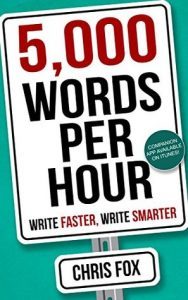
Pretty bold title hey? Chris Fox’s book has caught my eye for a good year or so, and I kept putting it off. After reading Story Gird, I figured I should finally give it a go. My writing speed wasn’t anywhere close to what I wanted. I’d be impressed if I could do 1,000 words in an hour. This book offers insight into how you can increase your speed by tracking your words per minute, remove distractions and set up a writing ritual. Ultimately it comes down to writing more frequently will improve your writing speed.
I have yet to reach the wonderful 5,000 words an hour (or apply everything mentioned in the book), but this resource did double my word count per hour. During NaNoWriMo, I averaged about 2,000 words an hour. Some days I did a bit more than that.
Story Genius: How to Use Brain Science to Go Beyond Outlining and Write a Riveting Novel by Lisa Cron
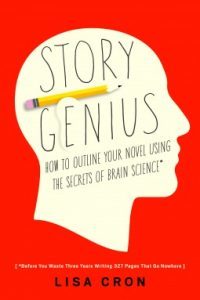
I picked up this book in October, so I haven’t finished it. So far it is worth the read. This book proposes complete opposite techniques mentioned in the Story Grid and 5,000 Words Per Hour by focusing on your protagonist internal story and less on external plotting events.
Summary of Finishing NaNoWriMo in Two Weeks
To recap what we covered:
Pre-Plan: This can be as detailed or as minimal as you want. Usually, the more you outline, the less work you have during NaNoWriMo. Study everything you can about your book, genre and time setting. If it is fantasy or science fiction, research often transcribes to world building. You’ll want to start pre-planning a couple of months in advance to give yourself plenty of time to explore.
Ritual: During NaNoWriMo keep a consistent routine. This is your new religion for the month, do it every day and keep at it. Don’t over-do it one day and exhaust yourself. You will cover more words over time.
Read: Resources are significant. Always practice and continue to learn as a writer. You’ll never stop finding ways to improve.
Comments? Additional Tips?
If you have questions, feedback or have insights into writing the first draft quickly, share them in the comments! We’d love to hear it.
The post How to Finish NaNoWriMo in Two Weeks appeared first on Konn Lavery.
Posts from konnlavery.com
- Konn Lavery's profile
- 156 followers


